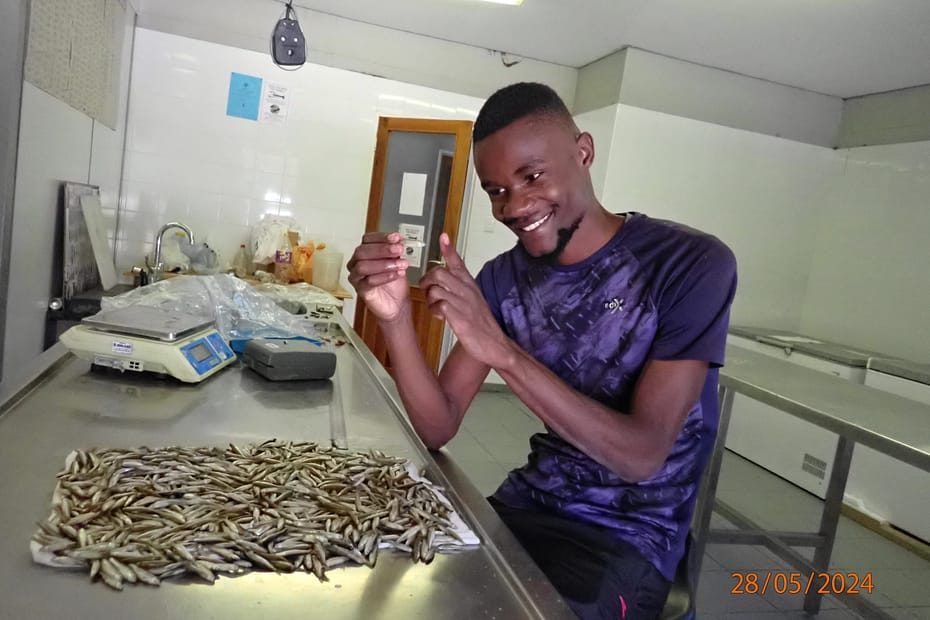Interview with Vilio Muunda
Vilio is a member of NYCE who works as a fisheries biologist at Kamutjonga Inland Fisheries Institute (KIFI) in Kavango East Region, under the Ministry of Fisheries and Marine Resources. He holds a Master of Science degree from the University of Namibia and is currently pursuing his PhD, focusing on the nutritional value and reproductive biology of freshwater fish. We wanted to find out more about his work as a young Namibian conservationist.
1. Why is the subject of good nutrition, specifically in children, important to you?
In the article, I mentioned that a recent study revealed about 43% of the current adults in Namibia have been undernourished during their early development and are therefore unlikely to attain their full growth potential. This has major consequences beyond that of the individual’s health: as the saying goes, “A healthy nation is a wealthy nation.”. It is of major concern that as of 2019, about 288,840 children under the age of five (5) in Namibia are not receiving the adequate diets fortified with all the necessary nutrients needed for child development. Proper nutrition is critical for a child’s physical and cognitive development – preventing conditions such as stunted and wasted growth.
2. What inspired you and your team to explore the role of freshwater fish in combating malnutrition in Namibia?
The statistics on malnutrition in Namibia are alarming for a country with a relatively small population, but unsurprising, given the climatic conditions. We produce a lot of fish from our ocean, but much of it is exported. With monotonic energy-based diets (i.e., mahangu porridge and meat) that prioritise caloric input over balanced nutrition, Namibians are often deficient in essential micronutrients such as vitamins B2, B3, B9, calcium and iron. Based on results from other countries, we know that freshwater fish have high concentrations of these micronutrients. However, little is known about the nutritional profiles of our local freshwater fish species. We need to better understand these fish and raise awareness about their potential role in addressing long-standing societal challenges such as malnutrition.
 © Vilio Muunda
© Vilio Muunda3. How feasible do you think it is to put more focus on inland fisheries for local consumption?
The Government of the Republic of Namibia, through the Ministry of Fisheries and Marine Resources, has already created an enabling policy environment for the sustainable utilisation of inland fisheries resources through the Inland Fisheries Resources Act of 2003 and the Aquaculture Act of 2002. Regulations are already in place to allow fishing from rivers and other water bodies, as well as the promotion of fish farming (aquaculture), which in turn reduces the pressure on wild fish populations.
4. What are some of the biggest challenges you have encountered when it comes to the consumption of freshwater fish among Namibian communities, particularly those in rural areas?
The availability of fish is threatened by various factors, such as the commercialisation of the fisheries and the use of illegal fishing gear like mosquito nets and monofilament nets. Poor rainfall upstream reduces floodwaters that are important for fish breeding, thus impacting fish abundance. Human activities and environmental factors may thus reduce fish stocks and limit the fish left for local people to eat.
5. How can Namibian government policies support the concept of inland fisheries to ensure long-term sustainability?
The policies are already in place to ensure the long-term sustainability of fisheries resources and their ecosystems. The greater challenge is implementation. Evidence-based adaptive management is needed to ensure that local communities and government authorities respond to current challenges in order to secure the future availability of fish for Namibian households.
 © Vilio Muunda
© Vilio Muunda6. Do you expect any future environmental risks or concerns if freshwater fish consumption increases significantly?
If the utilisation of freshwater fish increases sustainably, then environmental risks are likely to be minimal. However, if freshwater fishing is poorly regulated and commercialised rather than used for subsistence (as intended for by the Act), then the wild fisheries might be threatened. Be that as it may, the consumption of freshwater fish does not necessarily involve fishing from the rivers, as aquaculture can go a long way into ensuring increased consumption of freshwater fish without harming the wild fish population. If local households have small-scale fish farms to breed fish in their backyards, this will reduce the demand for fish from the rivers.
7. How can young Namibians get involved in initiatives such as these to create employment for themselves and their communities?
The good thing about aquaculture is that it not only provides for household consumption but can easily be scaled for profitability – especially if unemployed young people get involved to establish and run fish farms. The Ministry of Fisheries and Marine Resources provides free extension services to prospective fish farmers that include site assessment, water retention tests, and a suite of other recommendations. Further, they sell “fingerlings” (young fish) at a mere 20 cents per tilapia fish and commercial fish feed at highly subsidised prices to incentivise locals to venture into fish farming.
8. What further research is required to emphasise the need for freshwater fish as a sustainable nutritional solution in Namibia?
The Kavango River alone has over 80 different varieties of freshwater fish, yet the fisheries predominantly target about 10 of these species – typically large-bodied, slow-growing species. The small-sized, fast-growing and fast-reproducing species are often neglected as bycatch and are not at all used for aquaculture production. Given that they can reproduce quickly and in high numbers, these species could be very efficient for use in aquaculture. Further, given that they are consumed whole with head, scales and fins intact (unlike the big fish), they could provide key nutrients that are lacking and often lost during the preparation of large fish.
 © Vilio Muunda
© Vilio Muunda9. If you had the opportunity to make a policy recommendation based on your research findings, what would it be?
Since the legal frameworks are already firmly in place, my recommendations are more about action than policy. We need to increase our efforts to promote aquaculture and the consumption of freshwater fish as a means of addressing the nutritional deficiencies in Namibia. These should be coupled with comprehensive nutritional profiling of local freshwater fish species from Namibian rivers to identify the best species for farming. Specifically, further research should prioritise identifying nutrients prevalent in freshwater fish that are deficient in the diets of Namibian children.
Read full article here

